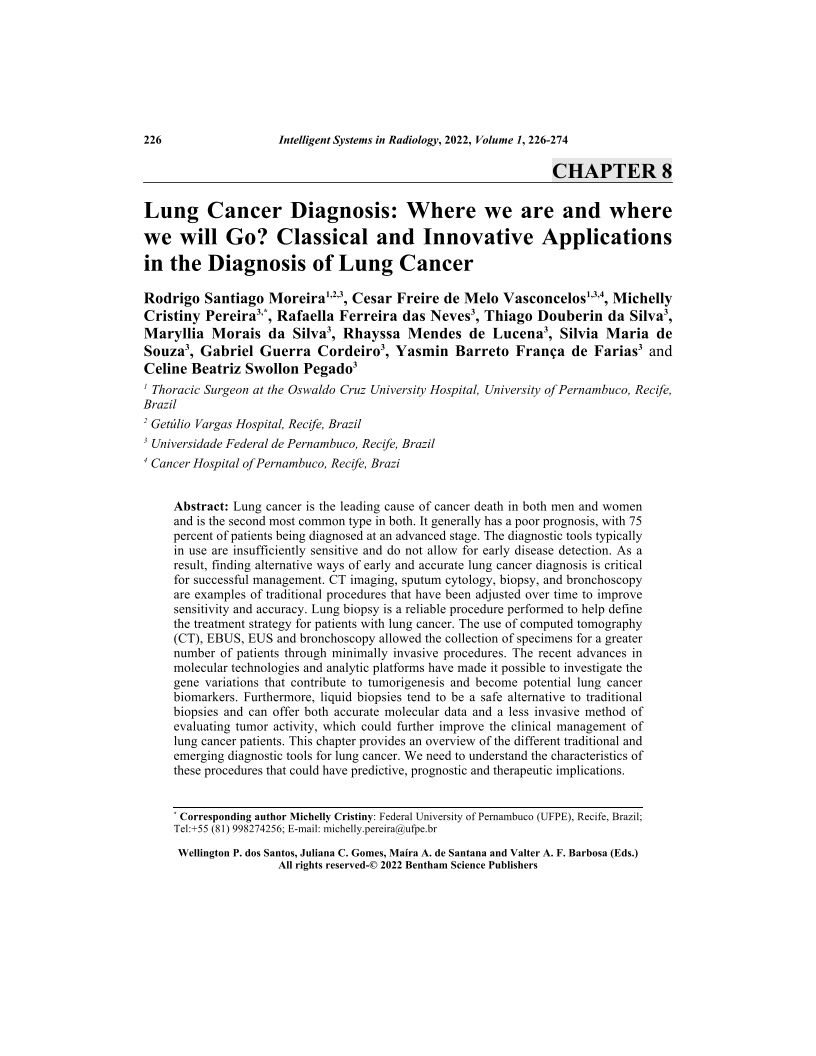Lung Cancer Diagnosis: Where we are and where we will Go? Classical and Innovative Applications in the Diagnosis of Lung Cancer

- Authors: Rodrigo Santiago Moreira1, Cesar Freire de Melo Vasconcelos2, Michelly Cristiny Pereira3, Rafaella Ferreira das Neves4, Thiago Douberin da Silva5, Maryllia Morais da Silva6, Rhayssa Mendes de Lucena7, Silvia Maria de Souza8, Gabriel Guerra Cordeiro9, Yasmin Barreto França de Farias10, Celine Beatriz Swollon Pegado11
-
View Affiliations Hide Affiliations1 Thoracic Surgeon at the Oswaldo Cruz University Hospital, University of Pernambuco, Recife, Brazil ⋅ Getúlio Vargas Hospital, Recife, Brazil ⋅ Universidade Federal de Pernambuco, Recife, Brazil 2 Thoracic Surgeon at the Oswaldo Cruz University Hospital, University of Pernambuco, Recife, Brazil ⋅ Universidade Federal de Pernambuco, Recife, Brazil ⋅ Cancer Hospital of Pernambuco, Recife, Brazil 3 Universidade Federal de Pernambuco, Recife, Brazil 4 Universidade Federal de Pernambuco, Recife, Brazil 5 Universidade Federal de Pernambuco, Recife, Brazil 6 Universidade Federal de Pernambuco, Recife, Brazil 7 Universidade Federal de Pernambuco, Recife, Brazil 8 Universidade Federal de Pernambuco, Recife, Brazil 9 Universidade Federal de Pernambuco, Recife, Brazil 10 Universidade Federal de Pernambuco, Recife, Brazil 11 Universidade Federal de Pernambuco, Recife, Brazil
- Source: Intelligent Diagnosis of Lung Cancer and Respiratory Diseases , pp 226-274
- Publication Date: July 2022
- Language: English
Lung Cancer Diagnosis: Where we are and where we will Go? Classical and Innovative Applications in the Diagnosis of Lung Cancer, Page 1 of 1
< Previous page | Next page > /docserver/preview/fulltext/9789815050509/chap8-1.gif
Lung cancer is the leading cause of cancer death in both men and women and is the second most common type in both. It generally has a poor prognosis, with 75 percent of patients being diagnosed at an advanced stage. The diagnostic tools typically in use are insufficiently sensitive and do not allow for early disease detection. As a result, finding alternative ways of early and accurate lung cancer diagnosis is critical for successful management. CT imaging, sputum cytology, biopsy, and bronchoscopy are examples of traditional procedures that have been adjusted over time to improve sensitivity and accuracy. Lung biopsy is a reliable procedure performed to help define the treatment strategy for patients with lung cancer. The use of computed tomography (CT), EBUS, EUS and bronchoscopy allowed the collection of specimens for a greater number of patients through minimally invasive procedures. The recent advances in molecular technologies and analytic platforms have made it possible to investigate the gene variations that contribute to tumorigenesis and become potential lung cancer biomarkers. Furthermore, liquid biopsies tend to be a safe alternative to traditional biopsies and can offer both accurate molecular data and a less invasive method of evaluating tumor activity, which could further improve the clinical management of lung cancer patients. This chapter provides an overview of the different traditional and emerging diagnostic tools for lung cancer. We need to understand the characteristics of these procedures that could have predictive, prognostic and therapeutic implications.
-
From This Site
/content/books/9789815050509.chap8dcterms_subject,pub_keyword-contentType:Journal -contentType:Figure -contentType:Table -contentType:SupplementaryData105

